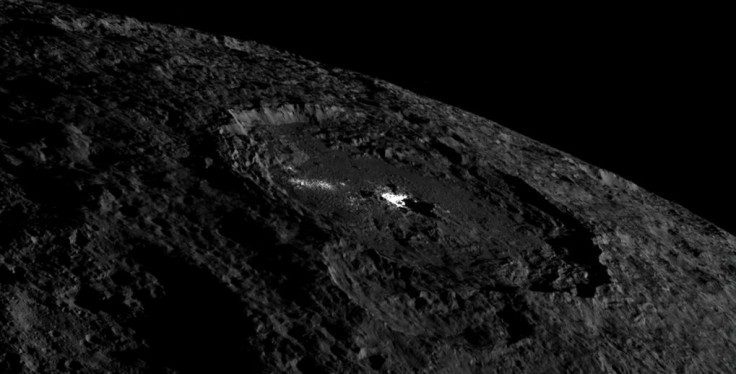Signs Of Extraterrestrial Life? NASA Scientists Say Eruptions On Dwarf Planet Ceres Indicate Possibility Of Living Things

Scientists are learning more about how the dwarf planet Ceres formed, with an eye on whether there could be extraterrestrial life there.
Until recently, a volcano on Ceres was erupting salty material from below the planet’s surface.
Well, it actually has been about 4 million years, but by our solar system’s standards that’s not all that long ago, especially considering that the crater in which scientists observed the evidence of that cryovolcanic activity is about 30 million years older, according to a study in the Astronomical Journal. For comparison, our solar system is almost 5 billion years old.
The Max Planck Institute for Solar System Research just announced the explosive finding, saying it means “Ceres is thus the body closest to the Sun that shows cryovolcanic activity.”
Read: Can the Dwarf Planet Ceres Support Life?
Experts could see the erupted material — which MPS referred to as “subsurface brine” and is mostly composed of mineral salts — in the dwarf planet’s Occator crater because it was brighter than everything else in the area, due to its youth. They analyzed data from a NASA space probe called Dawn that had been following Ceres along its orbit around the Sun and capturing images.
The information helps tell a story about how that part of Ceres formed, with a huge object crashing into the planet to create the 92-kilometer-wide Occator crater — but it also “triggered the later cryovolcanic activity,” MPS researcher Andreas Nathues said in the institute’s statement. With the impact, the brine moved up closer to the surface and eventually erupted.
Those eruptions may not be over. “Whether the cryovolcanic activity has ceased completely or is ongoing on a lower level is still unclear,” MPS said. “Pictures of the crater showing haze when imaged at certain angles seem to speak for the latter.”
The crater’s 92-kilometer diameter is significant given the size of the entire dwarf planet: 939 kilometers across, according to the Astronomical Journal study. That makes it the “largest object in the main asteroid belt,” which is between Mars and Jupiter.
At its closest point to Earth, the asteroid belt is about as far from us as the Sun, and at its furthest point is about double that distance. So why should we care how Ceres formed? Based on its potential to hold water, scientists are trying to determine whether it could hold life. “Water is essential for life, so it's possible that with this ingredient and a few other conditions met, life could maybe exist there,” according to NASA. “Living things on Ceres, if they are there at all, would likely be very small microbes similar to bacteria. And while Ceres might not have living things today, there could be signs it harbored life in the past.”
See also:
© Copyright IBTimes 2025. All rights reserved.





















